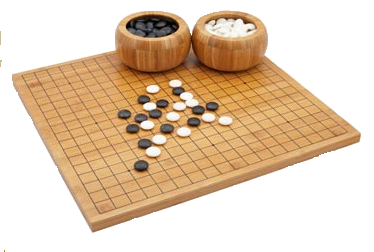Introduction [which can be skipped the first time through...]
The following positions are all very artificial and would rarely appear in actual games, but I use them to show some basic concepts of territory building. As you have probably noticed by now, a Go game does not generally start in one location and expand from there to cover the whole board. The beginning of a Go game usually consists of both players attempting to build new outposts in different corners of the board. Thus when it comes to the close infighting that I show here, a group in one corner can frequently lead into other stones separately established in another local area. It often becomes crucial to know whether or not those stones can be relied on as support or constitute a threat to continued expansion.A strange game
Take a good look at this following diagram.

Most people who have not seen this before would estimate that White has the larger territory, but count it. White has 11*11 = 121. Black has (38*2) + (30*2) = 136. So, not only has Black won, but she has won quite well. Now, of course, this is a very artificial situation, and could never occur in a real game. For one thing, Black has played 56 stones while White has only played 48.
Beginners may wonder whether White can invade the Black territory and make a living group. I'll just say no, but try to figure it out for yourself. In fact, if Black ignores White's move six times in a row, it is possible, but very unlikely.
[Can Black invade White's territory and live? Probably not: it would be like playing on an 11x11 go board when the edges are not "friendly" any more. I set this position up on a simple Go-playing computer program and was able to form a living Black group inside, but I feel sure that a strong player would have been able to stop me.]
This is a good illustration of a famous Go proverb: "the middle is always smaller than it looks." The fact that this strategy of "running along the third line" works on a 19x19 board means that it would be even more effective on a 13x13 or 9x9 board, where the middle territory would be even smaller.
The Line of Territory
Black's stones all lie on the third line from the edge, and the third line is often referred to as "the Line of Territory." Establishing a position on the third line is so important that the majority of openings [or joseki as they are called] start with a stone on the third line, and the two major variations that do not (5-4 and 4-4 openings] are usually answered by a move on the third line.Let's imagine that Black wants to create the situation in the diagram. As a first play, he takes a 3-3 point, at 1 [C3], which is a common opening, and White plays on top, which is the most common response. Black continues by moving along the third line, and White follows along, Up to this point this is all very conventional.

Now let's assume that Black wants to continue along the third line, White could play 6 [C4] and ensure that Black cannot get the third line along the left edge...

But that might lead to Black playing 7 [F4] and pushing along the fourth line

Now, if the third line is called the Line of Territory, the fourth line is called " the Line of Victory," (or sometimes "the Line of Influence." So - in this area at least, Black's expansion to the right is likely to be very profitable.
White will therefore probably not play 6 at C4, but at F3 instead, with a continuation like this.

Black still has the possibility of extending along the third line on the left-hand side, but the extension to the right has been pushed down to the second line, and, as you may imagine, this line also has a name. It is called "the Line of Defeat." White can continue pressing Black down with 10 atH3 (or even H2) and Black's final position will not be satisfactory.
What's next?
On this page we have been looking at extensions along the third line and what happens when the opponent is playing in the same area and contesting the extension. On the next page I will be looking at how best to extend when the opponent is not in the same area and what makes a good connection.
Send Tel a comment about this page
